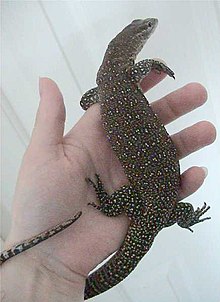Varanus timorensis, the Timor monitor[2] or spotted tree monitor,[3] is a species of small monitor lizards native to the island of Timor and some adjacent islands.[2]
| Varanus timorensis | |
|---|---|

| |
| Scientific classification | |
| Domain: | Eukaryota |
| Kingdom: | Animalia |
| Phylum: | Chordata |
| Class: | Reptilia |
| Order: | Squamata |
| Family: | Varanidae |
| Genus: | Varanus |
| Subgenus: | Odatria |
| Species: | V. timorensis
|
| Binomial name | |
| Varanus timorensis (Gray, 1831)
| |
| Synonyms | |
|
Monitor timorensis Gray, 1831 | |
This article needs additional citations for verification. (September 2023) |
Taxonomy
editKimberley rock monitors (Varanus glauerti), banded tree monitors (Varanus scalaris), and spotted tree monitors (Varanus similis) were once considered subspecies of the Timor monitor, but have since been elevated to full species status.
Currently, the peacock monitor (Varanus auffenbergi) is sometimes considered a subspecies, but is usually considered its own species.[2]
Description
editThe Timor monitor is a dwarf species of monitor lizard belonging to the subgenus Odatria. Generally, it is dark greenish-gray to almost black in background color, with bright gold-yellow or sometimes bluish spotting along its dorsal surface and a lighter straw-yellow color on its ventral side. It has a pointed snout, excellent eyesight and hearing, sharp teeth, and a prehensile tail that measures two-thirds of its total length. V. timorensis also has long, sharp claws well-suited for climbing and defense. The species grows to a maximum of 61 cm, and weighs between 100 and 350 g.
Habitat
editVaranus timorensis live in hollowed trees and branches, the spotted coloration helps them camouflage into the surrounding habitats.
Behavior
editTimor monitors are arboreal, diurnal lizards. Their diet consist of a variety of invertebrates, such as scorpions, orthopterans, spiders, mantids, bees and cockroaches, and other lizards, such as geckos, as well as small snakes.[4] Breeding takes place from December to March, and clutches of up to 11 eggs are laid; the eggs incubate three to four months, depending on the average temperature. Hatchlings are about 5 in long, but grow quickly.
Geographic distribution
editThe Timor monitor is found in Indonesia, specifically the islands of Timor, Savu, and Rote, and in East Timor.
In captivity
editFrequently bred in captivity, this monitor is also still imported in small numbers for the exotic pet trade. Wild-caught specimens can be nervous and difficult to handle, but captive-raised animals are much less shy.[citation needed]
References
edit- ^ Arida, E.; Reilly, S. (2021). "Varanus timorensis". IUCN Red List of Threatened Species. 2021: e.T83778959A101752375. Retrieved 19 November 2021.
- ^ a b c Auliya, Marc & Koch, André (2020). Visual Identification Guide for the Monitor Lizard Species of the World (Genus Varanus). Bonn, Germany: Bundesamt für Naturschutz. doi:10.19217/skr552. ISBN 978-3-89624-290-7.
- ^ Varanus timorensis at the Reptarium.cz Reptile Database. Accessed 27 April 2021.
- ^ "Varanus Timorensis".
- King, Dennis & Green, Brian. 1999. Goannas: The Biology of Varanid Lizards. University of New South Wales Press. ISBN 0-86840-456-X
